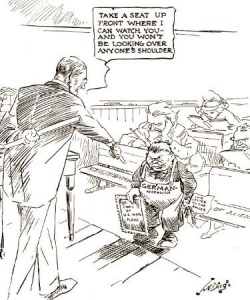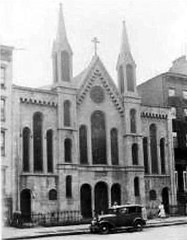From The Peopling of New York City
Contents |
Assimilation and Germanic Culture
In general German immigrants strongly resisted even small amounts of American assimilation. They felt tremendous pride in what they felt was a highly sophisticated culture. This system of values was collectively known as Deutschtum. To that end they instituted a myriad of measures aimed at preventing the dilution of their values and beliefs by the much more "plain" American mainstream. Among these were relatively simple methods such the banding together of the German workers into tight collectives to rather outlandish ones such as creating whole new sections of the city in order to create a German-only living environment. These measures were largely successful as marriage records circa 1890's showed less than 5% percent of the total German population to be married outside the German community. The Germans were finally forced to assimilate during the course of the two World Wars. The resentment and suspicion carried by the general American population forced made being openly German difficult.
Education and Language
The Germans believed that the prevention of assimilation must start at the early age. Children were often sent to parochial schools for the sole reason of teaching them exclusively in German with a German cultural atmosphere. While American culture was generally covered, German culture was strongly emphasized. For children learning in public schools such strict regulations were limited. It was mostly up to the parents to keep the children from being "seduced" by Americanism. When the German Americans were finally able to gain a measure of political clout they strove for and eventually passed legislation allowing for classes to be taught in German in New York public schools. This measure persisted for several decades until the events of World Wars I and II destroyed the German image.
Employment
Because of the general stigma against the Germans, there was heavy competition for jobs in the city. [2] The workers tended to band together as tight groups often forming worker's unions. Because of the difficulty in finding employment outside of the community most of them were employed under German industries. The owners, who had money and time to spare, often drove the anti-assimilation movement forward by encouraging their workers to stay within the community. One of the more drastic measures used to achieve that goal were employer towns. They were built by employers to house and service the factory workers. Two of the biggest employment town developers were Conrad Poppenhusen and William Steinway both of whom were strong believers in Deutschtum. The system was highly effective with other business from the Greater New York Area eventually moving to join the employer towns. These towns were little piece of Germany with beer gardens and theaters to hold cultural events.
Religion
The church services were some of the biggest catalysts to anti-assimilation movement. Because religion played such a tremendous role in the lives of everyday Germans, even for the new immigrants, a schism was inevitable. [3] The new German immigrants who have yet to master the English language were assailed by sermons in a foreign tongue. They found little of the comfort they sought at such congregations. This caused an outcry in the German community for church services to be performed in German. In the beginning these services were held in basements of churches with English sermons continuing unabated in the church house above. This eventually led to the establishment of completely separate churches and ministries that repeatedly clashed with the established order. A notable example was Pastor Friedrich Wilhelm Tobias Steimle. He was the leader of one of the first Lutheran churches and was so anti-Americanistic that he hung the word ‘Deutsch’ over the entrance to the parish. [4]
- Return to Assimilation
- Return to Germans
References
- ↑ http://www.exulanten.com/dingbat.html
- ↑ Lapham,Sigurd. The German-Americans of New York City 1860-1890. Pg 7. St. Johns University, 1977. Print.
- ↑ Lapham,Sigurd. The German-Americans of New York City 1860-1890. Pg 3. St. Johns University, 1977. Print.
- ↑ Lapham,Sigurd. The German-Americans of New York City 1860-1890. Pg 94-96. St. Johns University, 1977. Print.


